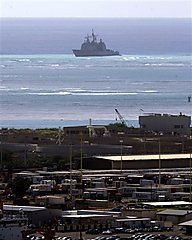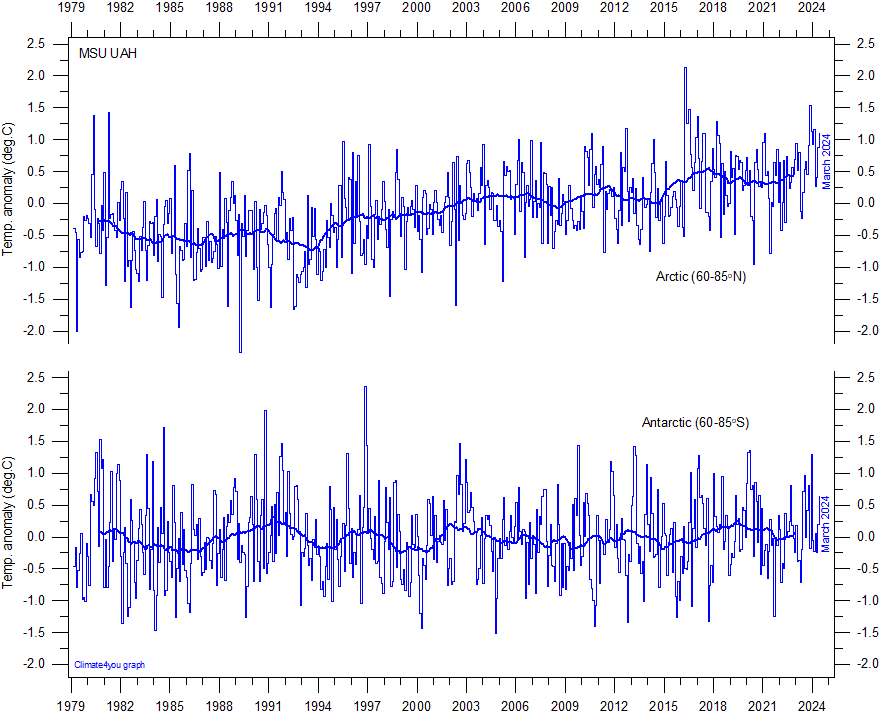Guided Missle Cruiser USS Port Royal aground at Oahu
One of the United States Navy's most advanced vessels ran aground 5 February 2009.
The 9,600 ton Ticonderoga-class Aegis guided missile cruiser USS Port Royal (CG-73) became stranded on a rock-and-sand shoal late last Thursday. At the time she was offloading sailors, contractors and shipyard personnel to a smaller vessel to be transferred ashore. Port Royal had just come out of a dry dock after undergoing maintenance and was undergoing its first after-maintenance sea trials.
The cruiser, with a draft of 33 feet, was hard aground on a shoal with a depth of no more than 22 feet. 200 tons of fuel and water were offloaded in addition to 15 tons of sailors to lighten the vessel. Despite that and the advantage of Full-Moon high tides, three attempts to tow the vessel off the sandbar were unsuccessful on the 6th, 7th, and 8th of February.
An additional 500 tons of water and 100 tons of anchors were offloaded and the warship was finally re-floated about 2 a.m. on the morning of 9 February.
So, how the heck did one of the Navy's most advanced warships--ostensibly sporting the most sophisticated navigational system in the known universe--run aground a stone's throw from it's home port? (If any of you seaworthy types can shed some light on this please leave a comment, because Uncle Sam isn't talking).
The ships' Commanding Officer, Captain John Carroll--skipper of the Port Royal since October 2008--has been relieved of his duties pending an investigation.
There has been much speculation as to the cause of the grounding and naturally eyes have been cast on the ship's Captain. He seems a worthy officer and I include his bio here (because no one else has bothered) from Port Royal's website:

The 9,600 ton Ticonderoga-class Aegis guided missile cruiser USS Port Royal (CG-73) became stranded on a rock-and-sand shoal late last Thursday. At the time she was offloading sailors, contractors and shipyard personnel to a smaller vessel to be transferred ashore. Port Royal had just come out of a dry dock after undergoing maintenance and was undergoing its first after-maintenance sea trials.
The cruiser, with a draft of 33 feet, was hard aground on a shoal with a depth of no more than 22 feet. 200 tons of fuel and water were offloaded in addition to 15 tons of sailors to lighten the vessel. Despite that and the advantage of Full-Moon high tides, three attempts to tow the vessel off the sandbar were unsuccessful on the 6th, 7th, and 8th of February.
An additional 500 tons of water and 100 tons of anchors were offloaded and the warship was finally re-floated about 2 a.m. on the morning of 9 February.
So, how the heck did one of the Navy's most advanced warships--ostensibly sporting the most sophisticated navigational system in the known universe--run aground a stone's throw from it's home port? (If any of you seaworthy types can shed some light on this please leave a comment, because Uncle Sam isn't talking).
The ships' Commanding Officer, Captain John Carroll--skipper of the Port Royal since October 2008--has been relieved of his duties pending an investigation.
There has been much speculation as to the cause of the grounding and naturally eyes have been cast on the ship's Captain. He seems a worthy officer and I include his bio here (because no one else has bothered) from Port Royal's website:

Captain John Carroll
Captain John Carroll was born and raised in Marshfield, Massachusetts. He graduated from Worcester Polytechnic Institute in May 1984 and was commissioned through Officer Candidate School in October 1984.
After completing nuclear power training and surface warfare basic training, he reported to Reactor Department in USS Enterprise (CVN 65) in Alameda, California. During this tour, he deployed to the Arabian Gulf and participated in Operation PRAYING MANTIS. Following this, Captain Carroll reported as the ASW Officer to USS Luce (DDG 38) homeported in Mayport, Florida, deploying on counter-drug operations in the Caribbean Sea and the Eastern Pacific Ocean.
From March 1991 to September 1993, he attended Naval Postgraduate School in Monterey, California , earning Masters of Science and Engineer Degrees in Mechanical Engineering.
Following Department Head School, Captain Carroll again reported to USS Enterprise (CVN 65) in Norfolk, Virginia as Reactor Controls Assistant, part of the crew taking CVN 65 out of the shipyard following her complex nuclear refueling overhaul. From June 1996 to February 1998, Captain Carroll served as Combat Systems Officer on USS Ford (FFG 54) out of Everett, Washington, participating in a battle group deployment to the Arabian Gulf.
Captain Carroll reported to USS Thach (FFG 43) in May 1998 in Yokosuka, Japan, as Executive Officer. During this tour, he deployed again to the Arabian Gulf conducting maritime intercept operations as part of a Maritime Expeditionary Force Group. After returning to Yokosuka , he oversaw one of the first forward deployed crew/hull swaps, becoming XO of USS Gary (FFG 51).
In October 1999, Captain Carroll reported to the staff of Commander, Naval Air Forces, U.S. Pacific Fleet as Deputy Force Nuclear Propulsion Officer and Officer-in-Charge of the Pacific Surface Nuclear Propulsion Mobile Training Team.
Captain Carroll took command of USS Rodney M. Davis (FFG 60), homeported in Everett, Washington, in May 2002. He deployed to the Arabian Gulf as part of NIMITZ Strike Group supporting Operations IRAQI FREEDOM and ENDURING FREEDOM. During his tour, ending in March 2004, Rodney M. Davis was the winner of the Battle Efficiency Award, the Golden Anchor and the CNO Safety Award.
Captain Carroll reported to the USS George Washington (CVN 73) in November 2004 where he served as the Reactor Officer until May 2007, completing two drydocking availabilities and preparing the ship for its transfer to Yokosuka, Japan.
Captain Carroll recently graduated from the Industrial College of the Armed Forces. In October 2008, he assumed command of USS Port Royal (CG 73). His individual awards include the Meritorious Service Medal (four awards), the Navy and Marine Corps Commendation Medal (two awards), and the Navy and Marine Corps Achievement Medal (two awards).
After completing nuclear power training and surface warfare basic training, he reported to Reactor Department in USS Enterprise (CVN 65) in Alameda, California. During this tour, he deployed to the Arabian Gulf and participated in Operation PRAYING MANTIS. Following this, Captain Carroll reported as the ASW Officer to USS Luce (DDG 38) homeported in Mayport, Florida, deploying on counter-drug operations in the Caribbean Sea and the Eastern Pacific Ocean.
From March 1991 to September 1993, he attended Naval Postgraduate School in Monterey, California , earning Masters of Science and Engineer Degrees in Mechanical Engineering.
Following Department Head School, Captain Carroll again reported to USS Enterprise (CVN 65) in Norfolk, Virginia as Reactor Controls Assistant, part of the crew taking CVN 65 out of the shipyard following her complex nuclear refueling overhaul. From June 1996 to February 1998, Captain Carroll served as Combat Systems Officer on USS Ford (FFG 54) out of Everett, Washington, participating in a battle group deployment to the Arabian Gulf.
Captain Carroll reported to USS Thach (FFG 43) in May 1998 in Yokosuka, Japan, as Executive Officer. During this tour, he deployed again to the Arabian Gulf conducting maritime intercept operations as part of a Maritime Expeditionary Force Group. After returning to Yokosuka , he oversaw one of the first forward deployed crew/hull swaps, becoming XO of USS Gary (FFG 51).
In October 1999, Captain Carroll reported to the staff of Commander, Naval Air Forces, U.S. Pacific Fleet as Deputy Force Nuclear Propulsion Officer and Officer-in-Charge of the Pacific Surface Nuclear Propulsion Mobile Training Team.
Captain Carroll took command of USS Rodney M. Davis (FFG 60), homeported in Everett, Washington, in May 2002. He deployed to the Arabian Gulf as part of NIMITZ Strike Group supporting Operations IRAQI FREEDOM and ENDURING FREEDOM. During his tour, ending in March 2004, Rodney M. Davis was the winner of the Battle Efficiency Award, the Golden Anchor and the CNO Safety Award.
Captain Carroll reported to the USS George Washington (CVN 73) in November 2004 where he served as the Reactor Officer until May 2007, completing two drydocking availabilities and preparing the ship for its transfer to Yokosuka, Japan.
Captain Carroll recently graduated from the Industrial College of the Armed Forces. In October 2008, he assumed command of USS Port Royal (CG 73). His individual awards include the Meritorious Service Medal (four awards), the Navy and Marine Corps Commendation Medal (two awards), and the Navy and Marine Corps Achievement Medal (two awards).










Captain Carroll was a terrible officer and would have made a terrible captain. In his own words, "I finished at the bottom of my class, and look at me now. I'm a department head!" (referring to his dismal tenure as Reactor Officer aboard the George Washington ).
ReplyDeleteThe man caused a reactor-related incident and shirked blame for it to one of his LDO's in the department.
Truly worthless.
Thank you for your commment and the information.
ReplyDeleteThat might certainly explain why no one was looking out the window when she went aground.